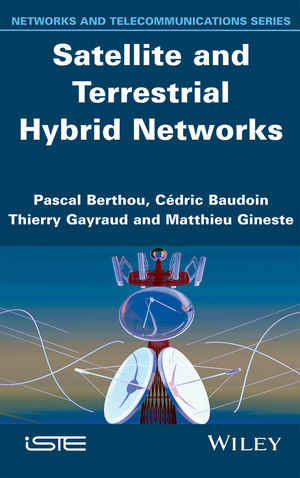
Satellite and Terrestrial Hybrid Networks
ISTE Ltd and John Wiley & Sons Inc (Verlag)
978-1-84821-541-2 (ISBN)
Pascal Berthou is associate professor at the Toulouse University of Sciencea and a researcher at Laboratory for the Analysis and the Architecture of Systems of the French National Center for Scientific Research (LAAS-CNRS), Toulouse, France.
Acknowledgments ix
Foreword xi
Patrick GÉLARD
List of Acronyms xiii
Introduction xxiii
Chapter 1 Satellite and Terrestrial Hybrid Networks 1
1.1 Designing satellite and terrestrial hybrid networks 1
1.2 Hybrid scenarios 2
1.2.1 Network architecture: integration of hybrid networks 4
1.2.2 Tight coupling integration: an integrated approach 5
1.2.3 Gateway integration 7
1.2.4 Loose coupling integration 8
1.3 Case study: loose coupling integration 9
1.3.1 Use case and user profile 9
1.3.2 Proposal of a scenario 9
1.3.3 Profile of mobile users 11
1.4 Conclusion 12
Chapter 2 Quality of Service on Next- Generation Terrestrial Networks 15
2.1 IETF approach 16
2.1.1 Network level 16
2.1.2 Transport level 29
2.1.3 Session and application levels 32
2.1.4 QoS signaling 37
2.2 ITU-NGN approach 45
2.2.1 Principles 45
2.2.2 Transport stratum 47
2.2.3 Service stratum 49
2.2.4 Management plan 50
2.3 Conclusion 50
Chapter 3 Quality of Service in Dvb-s/rcs Satellite Networks 53
3.1 Bi-directional satellite access systems 54
3.1.1 Overview 54
3.2 The DVB-S standard and the IP support 59
3.2.1 The DVB-S standard 60
3.2.2 Access method 63
3.2.3 IP encapsulation method over DVB-S 63
3.3 The DVB-S2 standard 67
3.3.1 Coding and modulations 67
3.3.2 Encapsulation 69
3.4 The DVB-RCS standard 70
3.4.1 Access method: MF-TDMA 71
3.4.2 Signaling in a DVB-RCS/S System 74
3.4.3 Connections 78
3.5 Dvb-rcs2 79
3.5.1 Coding and modulation 79
3.5.2 Access techniques 79
3.5.3 Encapsulation 80
3.5.4 QoS architecture and PEP 80
3.6 QoS architecture in DVB-S/RCS satellite access networks 80
3.6.1 The various stakeholders in the satellite network 81
3.6.2 The SatLabs architectural model 82
3.6.3 The BSM architectural model based on IP 89
3.7 Conclusion 96
Chapter 4. Integration of Satellites Into IMS Qos Architecture 97
4.1 IMS architecture 97
4.1.1 COPS and DIAMETER messages 99
4.2 IMS QoS architecture 100
4.2.1 IMS QoS in a GPRS: UMTS network 103
4.2.2 IMS QoS in an asymmetric digital subscriber line (ADSL) network 106
4.3 IMS QoS signaling 107
4.3.1 Authorization of QoS resources 108
4.3.2 Reservation of QoS resources with a local service policy 110
4.3.3 Approval of commitments of authorized resources 110
4.3.4 Deleting commitments of authorized resources 112
4.3.5 Revocation of a QoS resource authorization 112
4.3.6 Indication of a PDP context deletion 113
4.3.7 Authorization for the modification of the PDP context 115
4.4 Inclusion of IMS QoS in the satellite segment 116
4.4.1 “System” hypothesis 116
4.4.2 IMS satellite integration: transparent approach 117
4.4.3 IMS satellite integration: integrated star approach 118
4.4.4 IMS satellite integration: integrated mesh approach 119
4.5 Toward a unified next-generation network (NGN) QoS architecture 120
4.5.1 Transparent integration scenario 120
4.5.2 Star integration scenario 125
4.5.3 Mesh integration scenario 127
4.6 SATSIX project 130
4.7 Conclusion 132
Chapter 5 Inter-system Mobility 135
5.1 Introduction 135
5.2 The taxonomy of mobility 136
5.2.1 Personal mobility 136
5.2.2 Session mobility 137
5.2.3 Mobility of service 137
5.2.4 Mobility of the terminal 137
5.2.5 Network mobility 139
5.2.6 Clarification for mobility terminology 139
5.3 Protocols for mobility management 139
5.3.1 Extension of DVB-RCS for mobility 140
5.3.2 Management by the network layer: mobile IP 141
5.3.3 Mobility management with session initiation protocols (SIPs) 156
5.4 Implementation of mobility solutions in hybrid systems 159
5.4.1 Specification of SIP mobility in a DVB-S2/RCS system 160
5.4.2 Theoretical evaluations and recommendations 165
5.5 SIP for mobility management and QoS for interactive applications 177
5.6 Evaluation of mobility solutions in a simulated DVB-S2/RCS architecture 179
5.6.1 Comparison of interruption times 180
5.6.2 Common cases 180
5.6.3 Specific cases 183
5.6.4 Problems related to overheads 184
5.7 Conclusion 185
Chapter 6. the Transport Layer in Hybrid Networks 187
6.1 Introduction 187
6.2 Performance enhancing proxies 189
6.2.1 Space communications protocol specifications 190
6.2.2 I-pep 193
6.2.3 Issues related to PEPs 196
6.3 TCP evolutions 198
6.3.1 TCP adaptations to the satellite environment 199
6.3.2 Options and mechanisms for TCP improvements 200
6.3.3 New TCP versions 202
6.3.4 Characteristics of the satellite connection 204
6.3.5 Impact on the transport layer 206
6.3.6 Conclusion 207
6.4 TCP performance in a geostationary network 208
6.4.1 Measurement and analysis methodology 208
6.4.2 The configuration of the system and measurements 208
6.5 TCP in a hybrid context 215
6.5.1 The impact of a hybrid network on the transport layer 215
6.5.2 Control of the adaptation of streams to the new network 216
6.5.3 TCP impacts for a break before make handover 217
6.5.4 TCP impacts for a make before break handover 217
6.5.5 The effect on TCP of the vertical handover with simultaneous variation of the bandwidth and delay 218
6.5.6 Conclusion 220
6.6 General conclusion 221
Conclusion 223
Bibliography 227
Index 235
| Verlagsort | London |
|---|---|
| Sprache | englisch |
| Maße | 165 x 241 mm |
| Gewicht | 549 g |
| Themenwelt | Naturwissenschaften ► Physik / Astronomie ► Mechanik |
| Technik ► Elektrotechnik / Energietechnik | |
| Technik ► Nachrichtentechnik | |
| ISBN-10 | 1-84821-541-X / 184821541X |
| ISBN-13 | 978-1-84821-541-2 / 9781848215412 |
| Zustand | Neuware |
| Haben Sie eine Frage zum Produkt? |
aus dem Bereich


